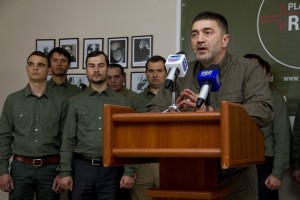A Second Crimea?
International fears mount as the Russian military seems to shift focus towards Moldova. On April 9, Russian forces were seen conducting military exercises in Transnistria, an autonomous region neighboring Moldova, and unrecognized by the UN. These exercises occurred just 24 hours before Moldovan Prime Minister Chiril Gaburici was scheduled to visit the region and meet with Transnistria’s current leader, Evgheni Sevciuk, in Tiraspol to smooth over the rocky relationship between the two neighbors. According to local sources, approximately 400 Russian soldiers participated in the maneuvers and 100,000 heavy-duty projectiles were launched, an amount large enough to attract international attention. Since 1992, relations between Moldova, known to lean more toward the West than its pro-Russian neighbor Transnistria, have been everything but uneventful. Following the dissolution of the Soviet Union, Transnistria did not hesitate to declare independence from Moldova. Inhabitants of the small region cited the possibility of Moldova’s reincorporation into Romania as their main reason for declaring autonomy. They felt that assimilation into Romanian territory would require a separation from their Russian identities. Such fears are not unfounded; former Romanian president, Traian Basescu, was and remains a vocal advocate for Moldovan membership in the European Union. Today, Transnistria is still dominated by Russian-speakers and has hosted Russian troops since 1992 after a devastating civil war that claimed 1,500 lives. That same year, the Russian government sent troops into the region, backed by the argument that the ethnic Russians residing there must be protected.
Moldovan leaders, as well as other Eastern European nations, feel uneasy when faced with the prospect of a new “Crimea” so close to home. After all, Russian troops crossed their borders just two decades ago, and Moldovans fear that recent developments in Ukraine could prompt another similar Russian bout of military protection of ethnic Transnistrian Russians.
Many believe that the solution lies in reconciliation between Moldova and Transnistria. Moldovan news sources confirm that officials from the Bureau of Reintegration based in Chisinau, Moldova’s capital city, are scheduled to meet with Transnistrian officials in an effort to promote discussion between the two states. Previous attempts to do so were reportedly blocked by Transnistria who might have been discouraged by Moldovan accusations of falsifying its reasons for refusing reintegration. Relations between the two neighbors remain frosty and the recent Russian military presence on Moldova’s borders has only served to raise international concern about the future of Transnistrian-Moldovan relations.
The drills in Transnistria are part of a larger defense program adopted by the Russian government. Zaslon-2015 is the newest program in the Russian “anti-revolutionary” arsenal and the reason for a recent boom in Russian military activity. The Russian military intends to conduct maneuvers set to last eight days in six federal districts, including Crimea. The drills are meant to place soldiers in situations mimicking confrontations with a more “revolutionary” tone; the revolt in Kiev’s Independence Square comes to mind.
Vasiliy Pancenkov, a representative of the Russian ministry, described the extreme detail with which the drills are carried out. Simulations have included “the burning of tires and the throwing of stones and bottles.” Russian officials state that current military training is designed to prevent any conflicts reminiscent of “revolutionary” uprisings in Ukraine. Putin believes that Yanukovych was removed from office due to strong Western influence and fears that he may fall prey to the same fate. The extensive military preparation of Zaslon-2015 will alleviate these fears.

